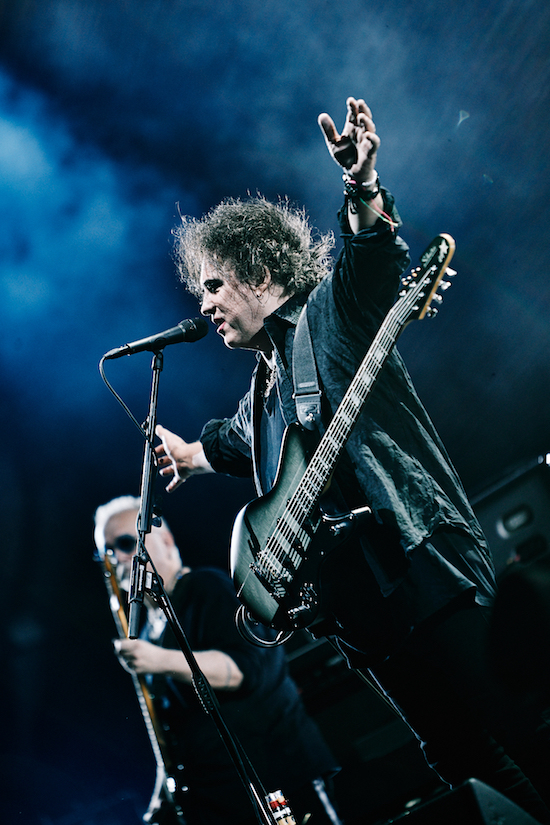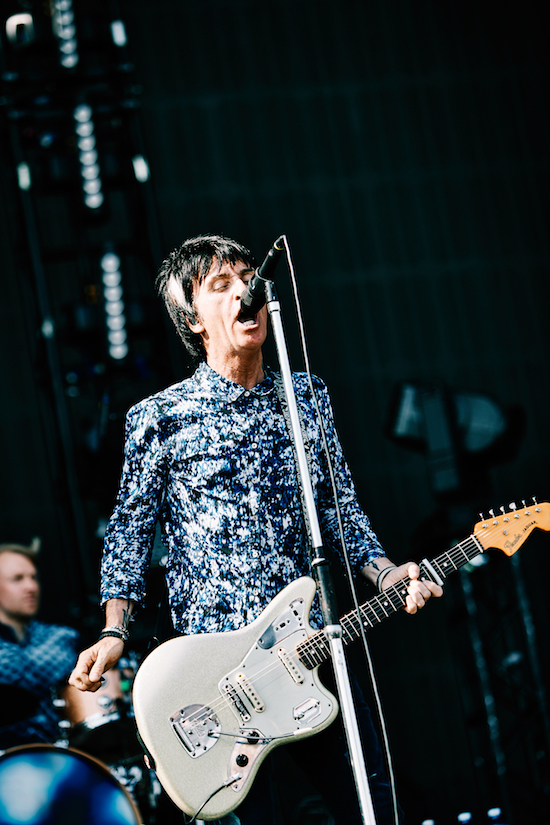Live photograph by Alberto Ortega
Beginning just a few years ago in 2016, Madrid’s Mad Cool has already established itself as one of Spain’s major alternative festivals alongside the likes of Primavera and Benicassim. The line-up also happens to sit somewhere between the two; with a dash of the more adventurous and interesting programing that Primavera offers alongside the kind of safe bet headliners that the latter serves up.
It’s a very broad offering as a result but it’s credit to the environment that the festival has already managed to create, and arguably European festival culture as a whole, that they can book the likes of lad favourites Noel Gallagher and Miles Kane alongside Vince Staples and Helena Hauff and it result in a weekend-long crowd that manages to feel relaxed yet engaged. A Brit-filled overseas piss up overflowing with stag dos painted as blue Smurfs this festival is not, and for obvious reasons it benefits from that – not least because it reached almost 40c on some days and a festival site free from lobster-red Brits who’ve been on the San Miguel since 11am is always a bullet dodged.
Instead, the festival succeeds in presenting a compact and thoughtfully designed site that, despite some of the frilly additions and brand-heavy offerings, very much has music as its core focus and priority. Here’s what was learned at this year’s edition.
Iggy Pop Can Do More In Four Songs Than Some Can Do In A Career
As Iggy skips onto the stage moving half like a creeping goblin and half like an excitable bounding child, the clanging chords for ‘I Wanna Be Your Dog’ begin to rumble and roar like a giant being rudely awoken. When the timeless riff comes fully to life, it surges with an electrified intensity that ripples through the crowd with palpable tension. It’s staggering to think the song is now fifty years old and of all the bands and genres it has been a blueprint for over the decades. Yet rather than come across as some antediluvian relic, the song has lost none of its potency; its raw, charging thrust still feels euphoric and gutsy and blood-pumping in its endlessly driving stomp. Then comes ‘Gimme Danger’, then ‘The Passenger’, followed by ‘Lust For Life’. As an opening four songs go, it feels as peerless as it does seamless. The crowd melt as Pop is in amongst the front row thrashing around mischievously as his band – including a powerful brass section – keeps the eruption overflowing.
The danger and wildness of early Iggy is of course subsided now he’s 72 and he may have lost most of the band members that gave some of these songs their original fury but across just these four tracks Iggy ricochets between infectious pop-rock to gut-churning noise in a manner that seems to encompass so much more than the number of songs he’s performed so far. Nobody can deny him a victory lap and this set – before he even gets to the likes of ‘Search And Destroy’, ‘TV Eye’ and ‘No Fun’ – feels like a growling, sweaty, guttural testament to a contribution to music that few others will ever come close to.

Live photography by Andres Iglesias
The Cure Remain On A Post-Glastonbury High
The Cure have been boosted by their greatly lauded Glastonbury headline set, as if carried on by the momentum generated by the closing flurry of pop hits. This propulsion, combined with the band having recently performed Disintegration in its entirety, means you have a set that is as loaded with material from their finest album as it is crowd-pleasing favourites. The opening jab-punch combo of ‘Plainsong’ and ‘Pictures Of You’ is enough to transport anyone who has spent hours locked in headphone introspection to that record to a place of profound beauty and warm gloomy solace. Smith’s voice has lost very little of its bite and tone over the years, shifting between controlled anguish and soaring fragility. The crushing lyrics to ‘Pictures Of You’ retain a powerful melancholic surge, as the accompanying music mixes immersive soundscapes with elegiac melody.
The moments from Disintegration do really sparkle; as a result of the band revisiting the whole album they have clearly come away from it newly invested and hearing the quiet beauty of ‘Lovesong’ or the at times ferocious ‘Fascination Street’ is thrilling. Beyond that, the band feel pretty unstoppable as they fire off track after track in a way that presents their contribution to music as one that is as vast as it is astonishing – from an impassioned and grinding ‘Shake Dog Shake’ to the elongated dreamy doom of ‘A Forest’.
For the encore the band play ‘Lullaby’, ‘The Caterpillar’, ‘The Walk’, Friday I’m In Love’, ‘Close To Me’, ‘Why Can’t I Be You’ and ‘Boys Don’t Cry’. It’s a finale so pop-loaded, you almost wonder for a moment if they’ll break out into ‘The Lovecats’. Thankfully they don’t but the closing run is so utterly joyous it enters into transcendence; a beautiful, swirling end to a show that manages to plunge the audience so deep inside the material you almost feel contained within its grasp.
Black Midi Already Feel Like They’ve Moved Past Their Debut Album
Currently sitting at number one in tQ’s mid-year poll for album of the year and only released a month ago, Black Midi may be considered neophytes by some but they appear to be moving at such a pace that Schlagenheim almost feels in their rearview mirror already. The conventional routine of touring an album and honing the songs to perfection night after night seems a banal prospect for the band. Instead, the fierce and unrelenting improvisers seem intent on unpicking, repacking and recontextualising their debut album in a framework that expands on the original improvisations that led to them arriving at the finished songs in the first place.
So the Slint meets Battles explosion of album opener ‘953’ is present and recognisable but it’s given range to roam, likewise the hyper-taut, crisp-dry minimalism of ‘Speedway’ goes into unpredictable territories and extended segues that make the return back to the familiar droning riff almost a toying and teasing experience. This approach can be both explosive and meandering, when the band lock into a groove – especially the galloping ones led by their monster drummer Morgan Simpson – they move along together in clattering bursts, fragmented rhythms and guitars that crack like thunder. In fact, you can usually tell when the band are locked into something pretty special because Simpson cannot help but let a huge smile take over his face as he looks for the dancing he’s spotted in the audience and lets their momentum drive him and the band forward. The nature of this approach means there’s the occasional lull, momentum sag or atonal diversion but the combination of never knowing what’s to come, along with the band’s clear disinterest in what’s expected of them, makes the experience a ceaselessly impulsive one in the hands of a group of sagacious young men.
Sometimes Less Is More
Due to the nature of potentially performing to so many new people on such a large stage, festivals have a tendency to trick some artists into thinking they need to elevate their stage show to levels they are uncomfortable with or that don’t support or enhance their music. Whilst of course the likes of Robyn benefits from an elegant and elaborate stage set up that is like stepping into Narnia and The Smashing Pumpkins’ giant illuminated dolls that sit behind them during a surprisingly engaging and hit-filled set work well, it’s often the more stripped-back sets that come out on top over the weekend.
Cat Power is an antidote to the clunky and garish production of Marina’s show and the car crash amateur theatrics of Perry Farrel’s Kind Heaven Orchestra. Stripped of any pomp and glitz, she plays a sun-soaked set that understands the importance of environment and allows the audience to sink into her voice and the subtle accompaniment as it oozes from the stage with the same fluidity as the sweat rolling down everyone’s forehead. Likewise Mogwai know that volume and lights are a powerful enough combination to work with and their refined, hush-to-eruption dynamics don’t require any audience pandering, even if ‘Remurdered’ has become something of an oft-deployed secret euphoria weapon for them to unleash. Similarly, sets from Sharon Van Etten and Let’s Eat Grandma are also trim, poised and efficient in their simplicity.

Live photograph by Andres Iglesias
Getting Away With It
Nobody can begrudge Johnny Marr for playing a few Smiths tracks; songs that he co-wrote and helped position as indelible contributions to British music. However, there’s also an inescapable and uncomfortable feeling that lingers over the songs at the moment, stemming from Morrissey’s ongoing putridness. Marr’s voice is distinct and in no way mirrors the original singer’s but it’s difficult to shake off the association – and squaring the lyrics against who Morrissey is now – despite how brilliant and deeply culturally embedded some of those songs remain.
However, what Marr does manage to do is to elevate his set beyond any toxic associations, which he has no part in, by reminding us what an adaptable, versatile and vital collaborator he has been over the years. The solo and Smiths tracks glide by nicely enough but when the band launch into Electronic’s ‘Getting Away With It’ the effect is pure buoyancy. The track, co-written with Neil Tenant and Bernard Sumner, is an untainted voyage through a perfect pop song that acts not so much as a palate cleanser but like a giant headfirst dunk into crisp icy waters and coming up new again. It’s an exuberant moment, which serves to illustrate that Marr’s contributions to contemporary pop music are not forever chained to one band.


